Answered step by step
Verified Expert Solution
Question
1 Approved Answer
show formulas for questions: 4-7 D E F 1 2 3 4 BUS 622 Case Study - Week 4 STUDENT NAME: Case Information: Years until
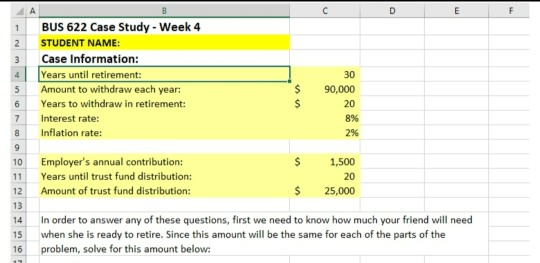
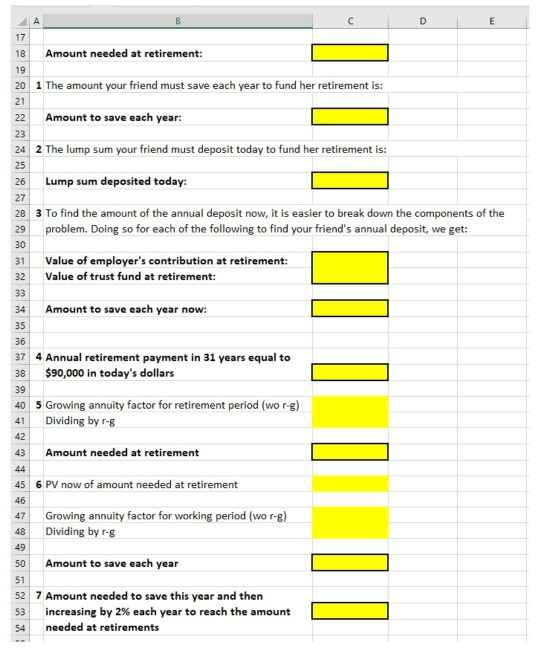
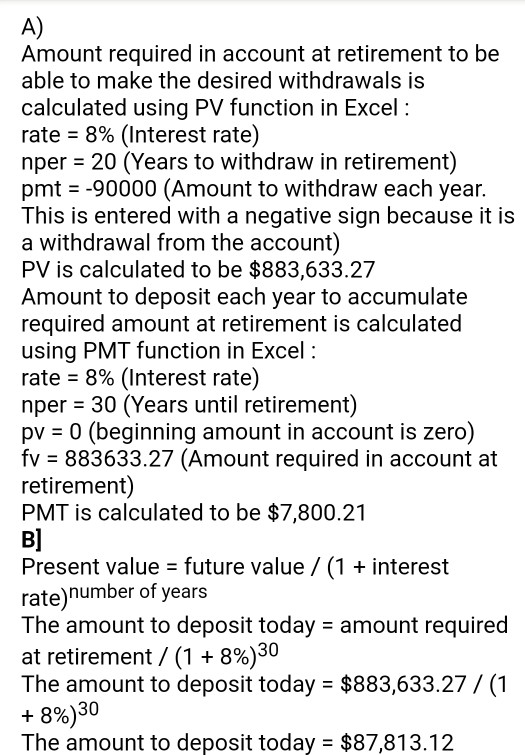
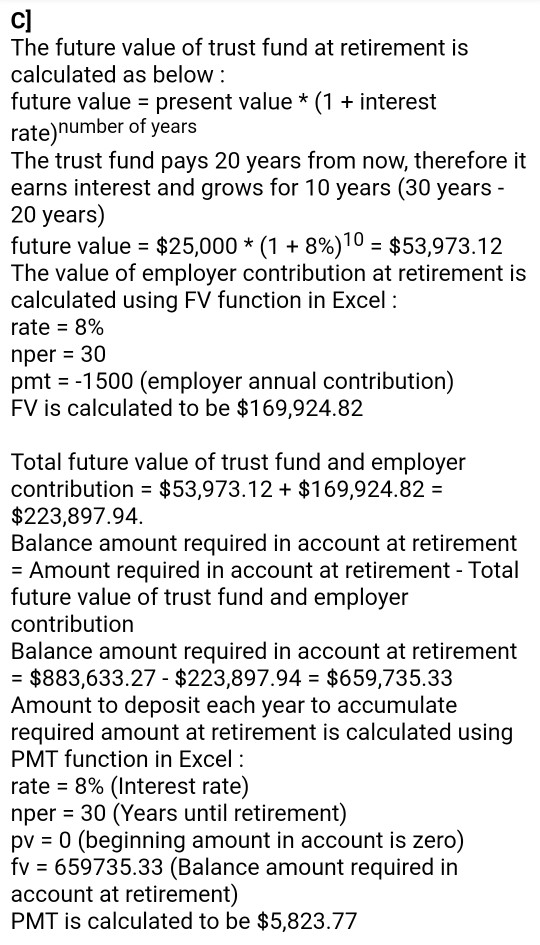
show formulas for questions: 4-7
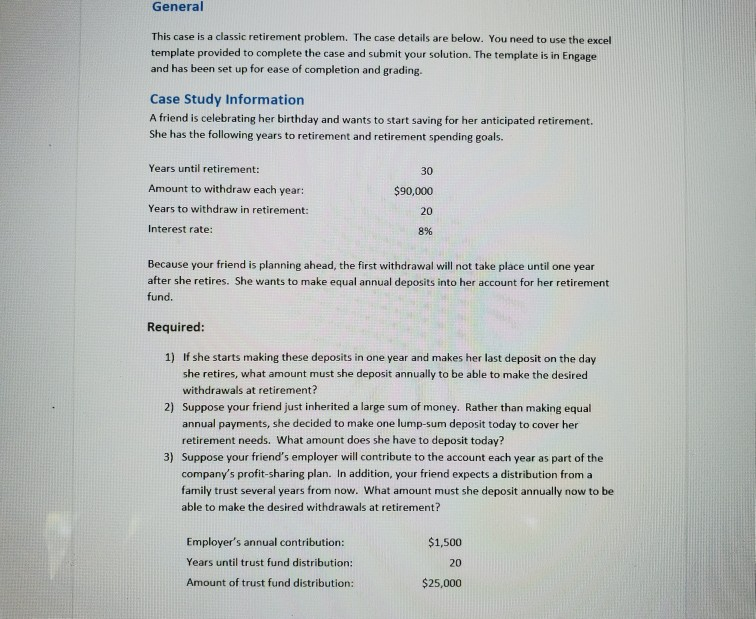
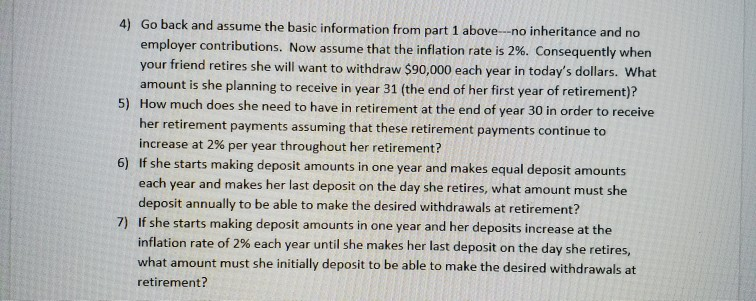
D E F 1 2 3 4 BUS 622 Case Study - Week 4 STUDENT NAME: Case Information: Years until retirement: Amount to withdraw each year: Years to withdraw in retirement: Interest rate: Inflation rate: 5 6 7 $ $ 30 90,000 20 8% 2% $ 9 10 11 12 13 Employer's annual contribution: 1,500 Years until trust fund distribution: 20 Amount of trust fund distribution: $ 25,000 In order to answer any of these questions, first we need to know how much your friend will need when she is ready to retire. Since this amount will be the same for each of the parts of the problem, solve for this amount below: 15 16 A D E 17 18 19 Amount needed at retirement: 20 1 The amount your friend must save each year to fund her retirement is: 21 22 23 Amount to save each year: 24 2 The lump sum your friend must deposit today to fund her retirement is: 25 26 Lump sum deposited today: 27 28 3 To find the amount of the annual deposit now, it is easier to break down the components of the problem. Doing so for each of the following to find your friend's annual deposit, we get: 29 30 31 32 33 34 35 36 Value of employer's contribution at retirement: Value of trust fund at retirement: Amount to save each year now: 38 39 37 4 Annual retirement payment in 31 years equal to $90,000 in today's dollars 40 5 Growing annuity factor for retirement period (wor-g) Dividing by r-g Amount needed at retirement 41 42 43 456 PV now of amount needed at retirement 46 Growing annuity factor for working period (wor-g) Dividing by r-g 47 48 49 50 51 INO Amount to save each year 52 7 Amount needed to save this year and then 53 increasing by 2% each year to reach the amount 54 needed at retirements A) Amount required in account at retirement to be able to make the desired withdrawals is calculated using PV function in Excel : rate = 8% (Interest rate) nper = 20 (Years to withdraw in retirement) pmt = -90000 (Amount to withdraw each year. This is entered with a negative sign because it is a withdrawal from the account) PV is calculated to be $883,633.27 Amount to deposit each year to accumulate required amount at retirement is calculated using PMT function in Excel : rate = 8% (Interest rate) nper = 30 (Years until retirement) = 0 (beginning amount in account is zero) fv = 883633.27 (Amount required in account at retirement) PMT is calculated to be $7,800.21 B] Present value = future value / (1 + interest rate) number of years The amount to deposit today = amount required at retirement / (1 + 8%)30 The amount to deposit today = $883,633.27 / (1 + 8%)30 The amount to deposit today = $87,813.12 pv c] The future value of trust fund at retirement is calculated as below: future value = present value * (1 + interest rate) number of years The trust fund pays 20 years from now, therefore it earns interest and grows for 10 years (30 years - 20 years) future value = $25,000 * (1 + 8%) 10 = $53,973.12 The value of employer contribution at retirement is calculated using FV function in Excel : rate = 8% nper = 30 pmt = -1500 (employer annual contribution) FV is calculated to be $169,924.82 Total future value of trust fund and employer contribution = $53,973.12 + $169,924.82 = $223,897.94. Balance amount required in account at retirement = Amount required in account at retirement - Total future value of trust fund and employer contribution Balance amount required in account at retirement = $883,633.27 - $223,897.94 = $659,735.33 Amount to deposit each year to accumulate required amount at retirement is calculated using PMT function in Excel : rate = 8% (Interest rate) nper = 30 (Years until retirement) pv = 0 (beginning amount in account is zero) fv = 659735.33 (Balance amount required in account at retirement) PMT is calculated to be $5,823.77 General This case is a classic retirement problem. The case details are below. You need to use the excel template provided to complete the case and submit your solution. The template is in Engage and has been set up for ease of completion and grading. Case Study Information A friend is celebrating her birthday and wants to start saving for her anticipated retirement. She has the following years to retirement and retirement spending goals. 30 Years until retirement: Amount to withdraw each year: Years to withdraw in retirement: $90,000 20 Interest rate: 8% Because your friend is planning ahead, the first withdrawal will not take place until one year after she retires. She wants to make equal annual deposits into her account for her retirement fund. Required: 1) If she starts making these deposits in one year and makes her last deposit on the day she retires, what amount must she deposit annually to be able to make the desired withdrawals at retirement? 2) Suppose your friend just inherited a large sum of money. Rather than making equal annual payments, she decided to make one lump-sum deposit today to cover her retirement needs. What amount does she have to deposit today? 3) Suppose your friend's employer will contribute to the account each year as part of the company's profit-sharing plan. In addition, your friend expects a distribution from a family trust several years from now. What amount must she deposit annually now to be able to make the desired withdrawals at retirement? Employer's annual contribution: $1,500 Years until trust fund distribution: 20 Amount of trust fund distribution: $25,000 4) Go back and assume the basic information from part 1 above--no inheritance and no employer contributions. Now assume that the inflation rate is 2%. Consequently when your friend retires she will want to withdraw $90,000 each year in today's dollars. What amount is she planning to receive in year 31 (the end of her first year of retirement)? 5) How much does she need to have in retirement at the end of year 30 in order to receive her retirement payments assuming that these retirement payments continue to increase at 2% per year throughout her retirement? 6) If she starts making deposit amounts in one year and makes equal deposit amounts each year and makes her last deposit on the day she retires, what amount must she deposit annually to be able to make the desired withdrawals at retirement? 7) If she starts making deposit amounts in one year and her deposits increase at the inflation rate of 2% each year until she makes her last deposit on the day she retires, what amount must she initially deposit to be able to make the desired withdrawals at retirement
Step by Step Solution
There are 3 Steps involved in it
Step: 1

Get Instant Access to Expert-Tailored Solutions
See step-by-step solutions with expert insights and AI powered tools for academic success
Step: 2

Step: 3

Ace Your Homework with AI
Get the answers you need in no time with our AI-driven, step-by-step assistance
Get Started


